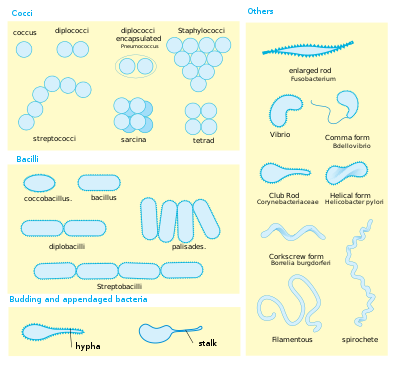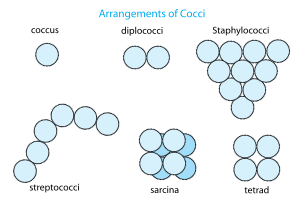Bacterial cellular morphologies
Bacteria and Archaea are classified by direct examination with the light microscope according to their morphology and arrangement.

The basic morphologies are spheres (coccus) and round-ended cylinders (bacillus). But there may be others such as helically twisted cylinders (spirochetes), cylinders curved in one plane (selenomonads) and unusual morphologies (such as the square, flat box-shaped cells of the archaean genus Haloquadratum). Arrangements include pairs, tetrads, clusters, chains and palisades.
Coccus


A coccus (plural cocci, from the Latin coccinus (scarlet) and derived from the Greek kokkos (berry)) is any microorganism (usually bacteria)[1] whose overall shape is spherical or nearly spherical.[2] Describing a bacterium as a coccus, or sphere, distinguishes it from bacillus, or rod. This is the first of many taxonomic traits for identifying and classifying a bacterium according to binomial nomenclature.
Important human diseases caused by coccoid bacteria include staphylococcal infections, some types of food poisoning, some urinary tract infections, toxic shock syndrome, gonorrhea, as well as some forms of meningitis, throat infections, pneumonias, and sinusitis.[3]
Arrangements
Coccoid bacteria often occur in characteristic arrangements and these forms have specific names as well;[4] listed here are the basic forms as well as representative bacterial genera:
- pairs or diplococci (eg. Neisseria spp.)
- groups of four or eight known respectively as tetrads and sarcina (eg. Micrococcus spp.)
- bead-like chains (eg. Streptococcus spp.)
- grapelike clusters (eg. Staphylococcus spp.)
Bacillus
A bacillus (plural bacilli) is a rod-shaped bacterium. Although Bacillus, capitalized and italicized, specifically refers to the genus, the word bacillus (plural bacilli) may also be used to describe any rod-shaped bacterium, and in this sense, bacilli are found in many different taxonomic groups of bacteria. There is no connection between the shape of a bacterium and its colors in the Gram staining.
Coccobacillus
A coccobacillus (plural coccobacilli) is a type of rod-shaped bacteria. The word coccobacillus reflects an intermediate shape between coccus (spherical) and bacillus (elongated).[8] Coccobacilli rods are so short and wide that they resemble cocci. Haemophilus influenzae and Chlamydia trachomatis are coccobacilli. Aggregatibacter actinomycetemcomitans is a gram negative coccobacillus which is prevalent in subgingival plaques. Acinetobacter strains may grow on solid media as coccobacilli.
Coxiella burnetti is also a coccobacillus.[9]
Spiral
Spiral bacteria are another major bacterial cell morphology.[10][11] Spiral bacteria can be sub-classified as spirilla, spirochetes, or vibrios based on the number of twists per cell, cell thickness, cell flexibility, and motility.
Bacteria are known to evolve specific traits to survive in their ideal environment[12]. Bacteria-caused illnesses hinge on the bacteria’s physiology and their ability to interact with their environment, including the ability to shapeshift. Researchers discovered a protein that allows the bacterium Vibrio cholerae to morph into a corkscrew shape that likely helps it twist into — and then escape — the protective mucus that lines the inside of the gut.[12]
References
- "coccus" at Dorland's Medical Dictionary
- Madigan M; Martinko J, eds. (2005). Brock Biology of Microorganisms (11th ed.). Prentice Hall. ISBN 0-13-144329-1.
- Ryan KJ; Ray CG, eds. (2004). Sherris Medical Microbiology (4th ed.). McGraw Hill. ISBN 0-8385-8529-9.
- Salton MRJ, Kim KS (1996). Baron S, et al. (eds.). Structure. In: Baron's Medical Microbiology (4th ed.). Univ of Texas Medical Branch. ISBN 0-9631172-1-1. (via NCBI Bookshelf).
- "Chapter 4: Functional Anatomy Of Prokaryotic And Eukaryotic Cells". Archived from the original on 23 September 2012.
- http://faculty.ccbcmd.edu/courses/bio141/lecguide/unit1/shape/shape.html
- Bacillus (shape)
- "Dorlands Medical Dictionary:coccobacillus".
- "persistent rickettsial disease".
- Csuros, Maria (1999). Microbiological Examination of Water and Wastewater. Boca Raton, Florida: CRC Press. pp. 16–17. ISBN 9781566701792.
- Young, Kevin D. (September 2006). "The Selective Value of Bacterial Shape". Microbiology and Molecular Biology Reviews. 70 (3): 660–703. doi:10.1128/MMBR.00001-06. PMC 1594593. PMID 16959965.
- "Cholera bacteria infect more effectively with a simple twist of shape". Princeton University. Retrieved 2017-09-15.
See also
- Bacterial morphological plasticity
- Ferdinand Cohn – gave first named shapes of bacteria